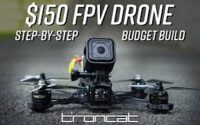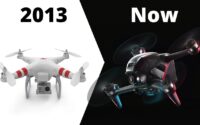Understanding the Risks of Drone Propellers and Ensuring Safety
Drone propellers can cause severe injuries due to their high-speed rotation and sharp blades. Safety measures like propeller guards help reduce the risk of direct contact. Maintaining a safe distance, wearing protective gear, and following guidelines are essential for safe drone operation.
Can Drone Propellers Hurt You?
Drone propellers pose a potential risk to human safety due to their high-speed rotation and sharp blades. – These spinning blades can cause severe injuries if they come into contact with a person. – Accidental collisions or loss of control can lead to propeller strikes, resulting in cuts, lacerations, or even amputations. – To mitigate this risk, manufacturers incorporate safety features like propeller guards to reduce the chances of direct contact. – However, these guards may affect flight performance and maneuverability, so they are not always used. – It is crucial for drone operators and bystanders to maintain a safe distance from drones in operation to avoid potential harm. – Additionally, pilots should undergo proper training and follow regulations to ensure responsible drone use. – The risk of propeller-related injuries can be minimized by understanding and adhering to safe operating procedures. – Always keep in mind that drones are powerful machines that require caution and respect to prevent accidents and harm.
Understanding Drone Propellers
Drone propellers, although small in size, can pose a potential danger if not handled with caution. – A propeller consists of rotating blades that generate thrust, enabling the drone to fly. – These blades are typically made of lightweight materials such as plastic or carbon fiber. – However, their speed and sharpness can cause harm if they come into contact with human skin or other objects. – It is important to maintain a safe distance from operating drones to prevent any accidental injuries. – Manufacturers often equip drones with propeller guards, which provide a layer of protection around the blades. – These guards help minimize the risk of direct contact between the propellers and individuals. – When using a drone, it is crucial to be aware of your surroundings and avoid flying near people or animals. – Furthermore, following the manufacturer’s guidelines regarding safe operation and maintenance is essential. – Regularly inspecting the propellers for any signs of damage or wear is necessary to ensure their optimal performance. – In the event of a crash or collision, propellers can become damaged and should be replaced if necessary. – Pilots should also be mindful of weather conditions as strong winds can affect propeller stability and control. – Understanding the basic principles of aerodynamics can assist in comprehending how propellers function and the risks associated with them. – Educating oneself about drone safety practices, including propeller handling, is essential for responsible drone operation. – By respecting the power of drone propellers and taking appropriate precautions, one can enjoy the benefits of drone technology safely and responsibly.
The Risks of Drone Propellers
-
Physical Injury: Drone propellers can cause serious physical harm if they come into contact with a person or object. The high-speed rotation of the propellers generates a significant amount of force, capable of cutting or lacerating human skin.
-
Eye Injuries: Drones with exposed propellers pose a particular risk to the eyes. A direct hit to the eye by a propeller can result in severe damage, leading to vision impairment or even permanent blindness.
-
Flying Debris: In the event of a collision or malfunction, drone propellers can break or detach, resulting in flying debris. These fragments can pose a danger to bystanders, causing cuts, bruises, or other injuries.
-
Hair and Clothing Entanglement: Long hair or loose clothing can get caught in the spinning propellers, leading to entanglement. This can cause pain, injuries, or even pull the person towards the drone, potentially causing further harm.
-
Noise-Related Issues: Drone propellers produce a loud noise, especially at high speeds. Prolonged exposure to this noise can cause hearing damage, leading to hearing loss or tinnitus.
-
Risk of Electric Shock: Some drones are powered by rechargeable batteries, which can pose a risk of electric shock if mishandled. If the propellers come into contact with electrical wires or components, there is a potential for injury.
-
Propeller Failure: Drones rely on the proper functioning of their propellers for stable flight. If a propeller fails mid-flight, the drone can become unstable, potentially crashing and causing damage or injury to people or property below.
-
Unauthorized Modifications: Modifying or replacing drone propellers with non-standard or incompatible parts can lead to unpredictable behavior. This can increase the risk of accidents, injuries, or damage to the drone itself.
-
Lack of Awareness: Many people may not be fully aware of the potential risks associated with drone propellers. This lack of awareness can lead to careless behavior, such as flying drones in crowded areas or near people, increasing the likelihood of accidents and injuries.
Minimizing the Risk of Injury
Minimizing the Risk of Injury: Can Drone Propellers Hurt You?
Drones have become increasingly popular for recreational and professional use, but it’s important to understand and minimize the risks associated with them, particularly regarding the potential harm caused by drone propellers. Here are some key considerations to ensure safety:
-
Keep a Safe Distance: Always maintain a safe distance between yourself and a drone in operation to avoid any contact with its propellers. The minimum recommended distance is usually around 5 meters.
-
Wear Protective Gear: When operating a drone or being in close proximity to one, wearing appropriate protective gear, such as goggles and gloves, can significantly reduce the risk of injury if an accident occurs.
-
Follow Manufacturer Guidelines: Adhere to the manufacturer’s guidelines and instructions for operating the drone. Familiarize yourself with the propeller safety instructions, including how to handle, attach, and detach them properly.
-
Propeller Guards: Consider using propeller guards, which are available for many drone models. These guards act as a protective barrier around the propellers, reducing the chances of injury in case of accidental contact.
-
Avoid Flying Near People or Animals: To minimize the risk of injury to others, refrain from flying drones in crowded areas or near people and animals. This precautionary measure is especially crucial when operating drones with exposed propellers.
-
Be Mindful of Weather Conditions: Strong winds can affect drone stability and control. Flying in adverse weather conditions increases the risk of accidents, including propeller-related injuries. Monitor weather forecasts and avoid flying in unfavorable conditions.
-
Be Cautious During Takeoff and Landing: Exercise caution during takeoff and landing, as these phases often pose a higher risk of accidents. Maintain a safe distance, and ensure that no one is within the proximity of the drone’s flight path.
-
Invest in Training: If you’re new to drones or have limited experience, consider taking a training course to learn about safe operation and proper handling techniques. Knowledge and skills acquired through training can help prevent accidents.
-
Inspect and Maintain Your Drone: Regularly inspect your drone for any signs of damage or wear, paying particular attention to the propellers. Replace damaged or worn-out propellers promptly to maintain optimal performance and minimize the risk of accidents.
-
Stay Updated with Regulations: Stay informed about local regulations and restrictions regarding drone operation. Compliance with these regulations not only ensures your safety but also promotes responsible and ethical drone usage.



